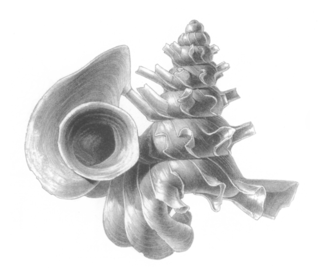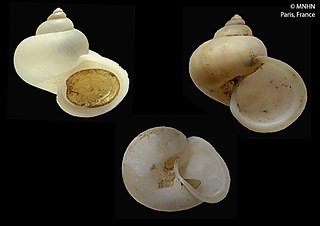
Georissa is a genus of minute land snails, terrestrial gastropod mollusks in the family Hydrocenidae. Although the species are best known for living on the surface of limestone rocks, they are often also found in and on the vegetation and on non-calcareous rocks. One species, Georissa filiasaulae, is cavernicolous. It is only known from two caves in the Sepulut area of Sabah, Malaysian Borneo, where its above-ground sister species, Georissa saulae, inhabits the rocks outside of the cave, and is connected to the cave snail via narrow zones of hybridization at the cave entrances. Possibly, G. filiasaulae has evolved without ever having been fully separated from its ancestor, a process known as speciation-with-gene-flow.

Japonia is a genus of land snails with opercula, terrestrial gastropods in the subfamily Cyclophorinae of the family Cyclophoridae.

Kaliella is a genus of air-breathing land snails or semi-slugs, terrestrial pulmonate gastropod mollusks in the family Chronidae.

Opisthostoma is a genus of minute land snails with opercula, terrestrial gastropod mollusks or micromollusks in the family Diplommatinidae.

Opisthostoma mirabile is a species of air-breathing land snail with an operculum, a terrestrial gastropod mollusk in the family Diplommatinidae.

Diplommatinidae is a family of small land snails, also known as staircase snails, with an operculum, terrestrial gastropod mollusks in the superfamily Cyclophoroidea. The Cochlostomatinae Kobelt, 1902, were previously considered a subfamily of the Diplommatinidae, but are now known to be a separate family.

Dyakiidae is a family of air-breathing land snails terrestrial pulmonate gastropod mollusks in the superfamily Trochomorphoidea.

Leptopoma perlucidum is a species of land snail with a gill and an operculum, a terrestrial gastropod mollusk in the family Cyclophoridae.
Opisthostoma vermiculum is a species of minute land snail with an operculum, a terrestrial gastropod mollusk or micromollusk in the family Diplommatinidae. The shell possesses four different coiling axes; the most for any known living gastropod. This member of the Diplommatinidae family is endemic to Malaysia. Its natural habitat is tropical limestone outcrops.

Menno Schilthuizen is a Dutch evolutionary biologist, ecologist, and permanent research scientist at Naturalis Biodiversity Center in Leiden and a professor of evolution and biodiversity at Leiden University.
Everettia is a genus of air-breathing land snails, terrestrial pulmonate gastropod mollusks in the family Dyakiidae.
Rathouisia pantherina is a species of carnivorous air-breathing land slug, terrestrial pulmonate gastropod mollusk in the family Rathouisiidae.
Plectostoma sciaphilum was a species of land snail in the family Diplommatinidae. This species was originally found on a single limestone karst at Bukit Panching, in Peninsular Malaysia. In 2007, this karst was quarried, thus destroying the only known site of occurrence for this species. Plectostoma species are allopatric, being in found in dozens of isolated karst hills where few species occur, meaning that limited gene flow exists and only negligible hybridization occurs. Shell is distinctly convex, tuba shape similar to that of Plectostoma senex and P. turriforme, but this species lacks basal constriction teeth. Shell height: 2.6–2.9 mm, width: 1.5–1.6 mm.

Angustopila dominikae is a species of light grey, round, land snails, a terrestrial pulmonate gastropod mollusc in the family Hypselostomatidae. Angustopila dominikae have been found in southern China, and are considered to be one of the world's smallest terrestrial molluscs. This species is a tropical snail found on limestone cliffs.

Acmella is a genus of minute, land snails with an operculum, gastropod mollusks, or micromollusks, in the family Assimineidae.

Plectostoma obliquedentatum is a species of air-breathing land snail with an operculum, a terrestrial gastropod mollusk in the family Diplommatinidae.

The Kinabatangan District is an administrative district in the Malaysian state of Sabah, part of the Sandakan Division which includes the districts of Beluran, Kinabatangan, Sandakan, Telupid and Tongod. The capital of the district is in Kinabatangan Town.
Angustopila psammion is a species of land snail belonging to the subfamily Hypselostomatinae of the family Gastrocoptidae. It was described in 2022.














